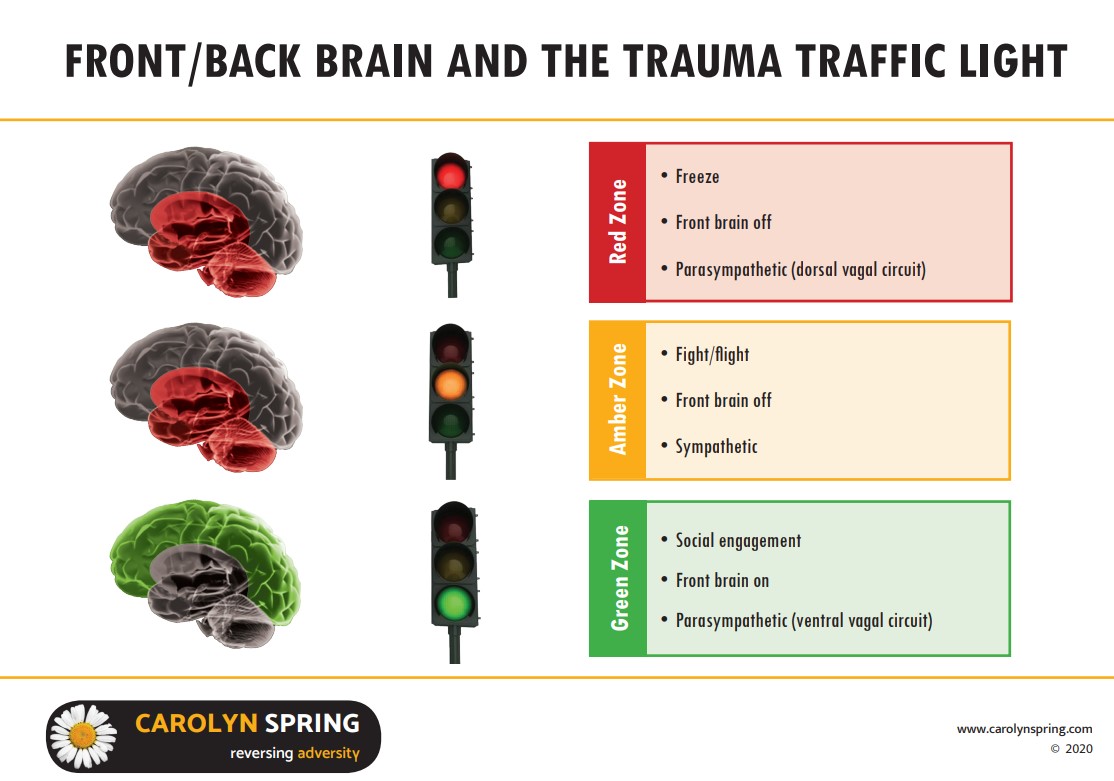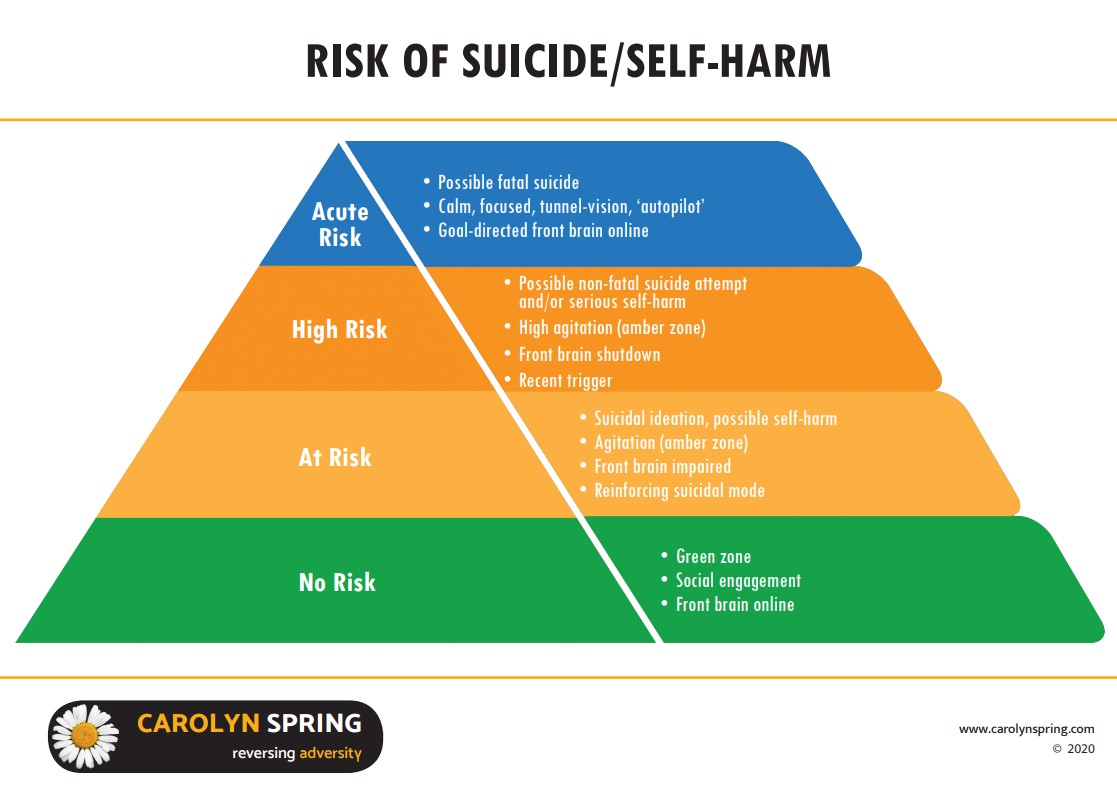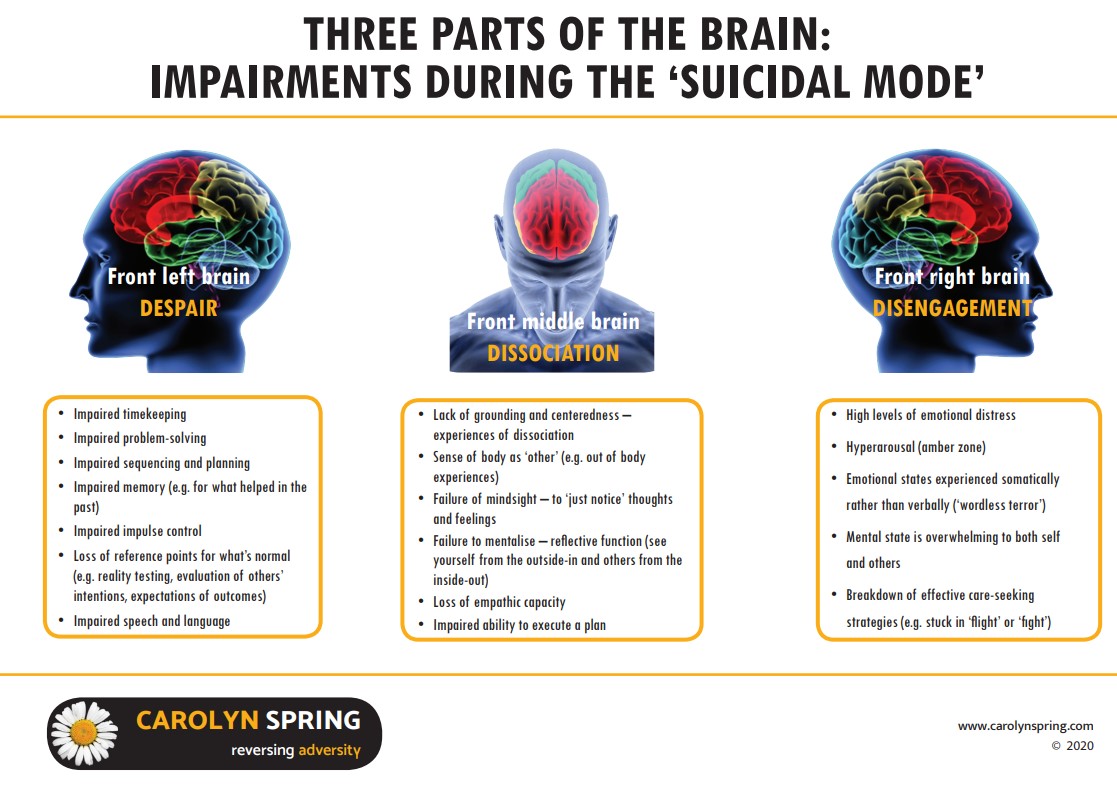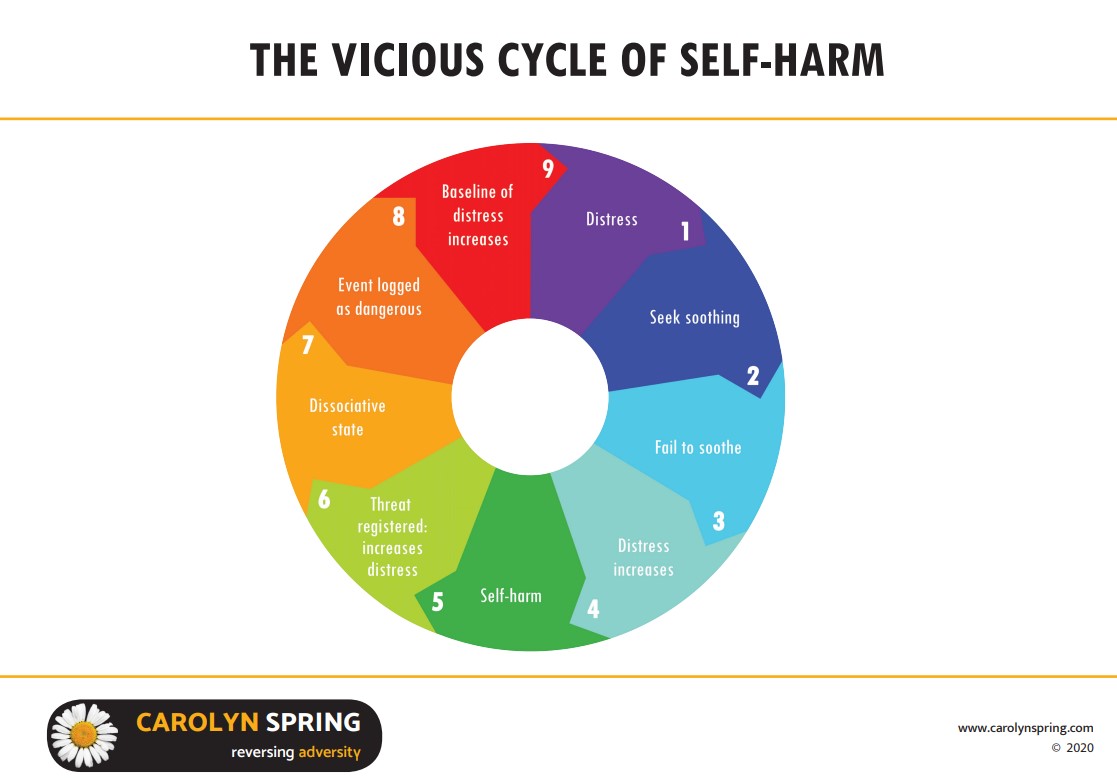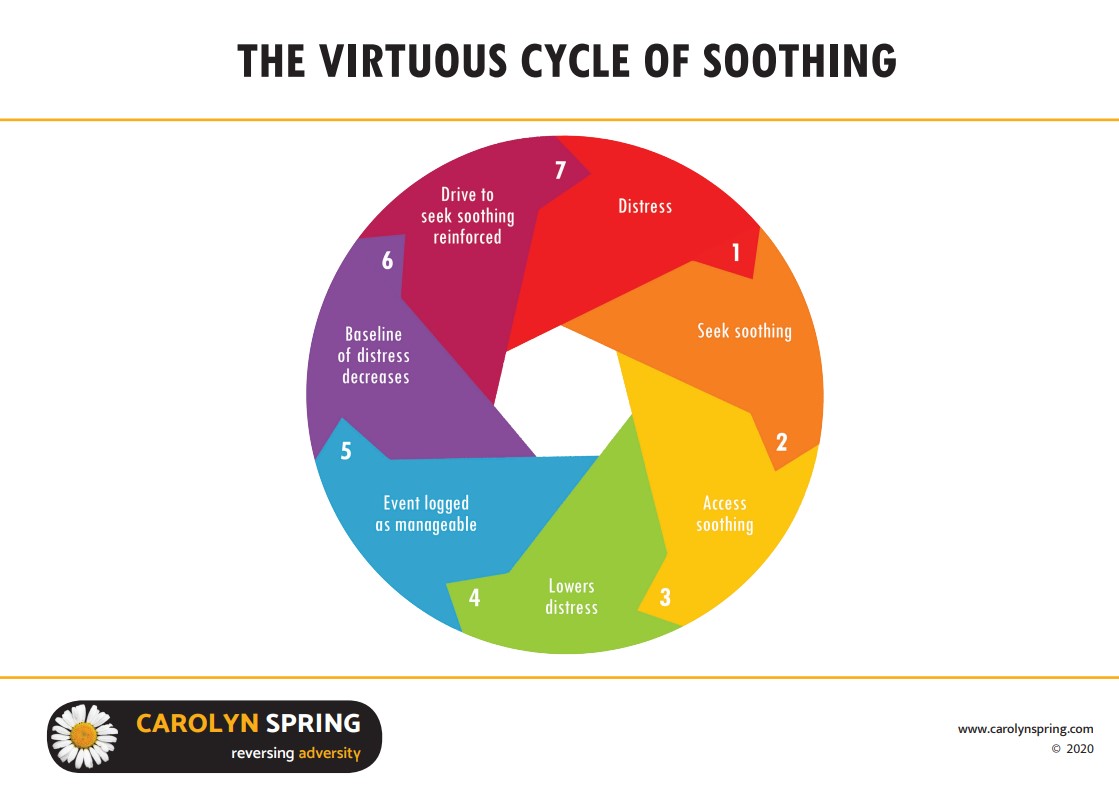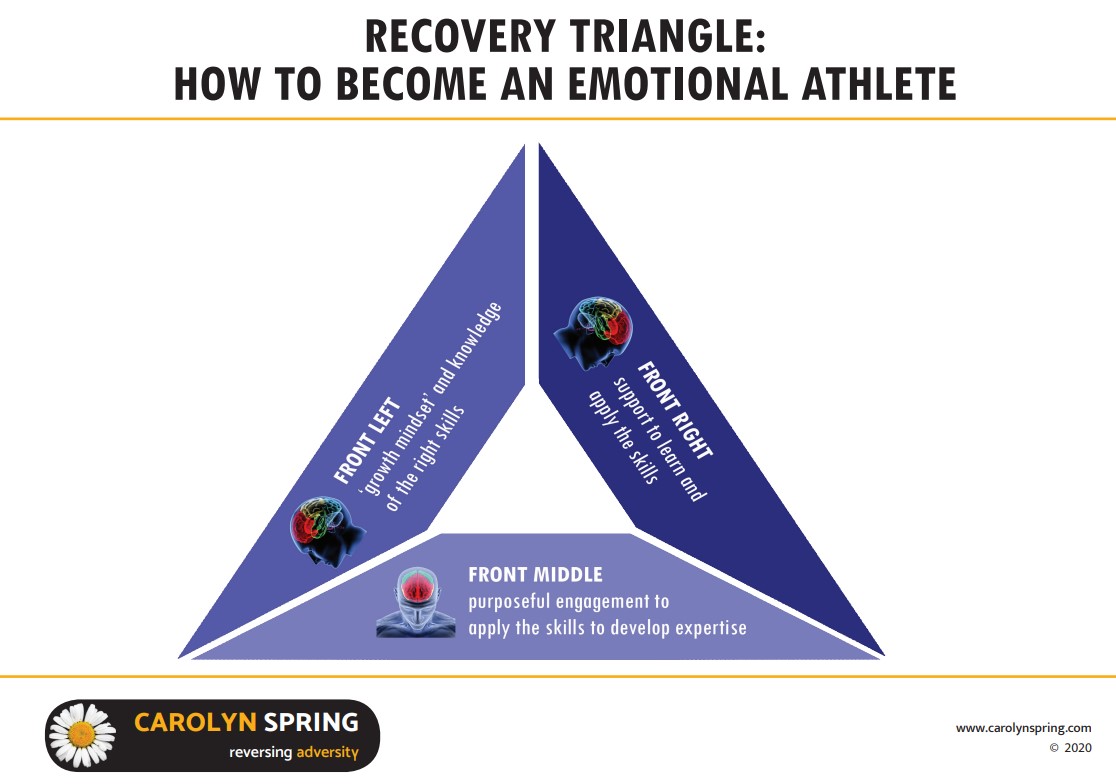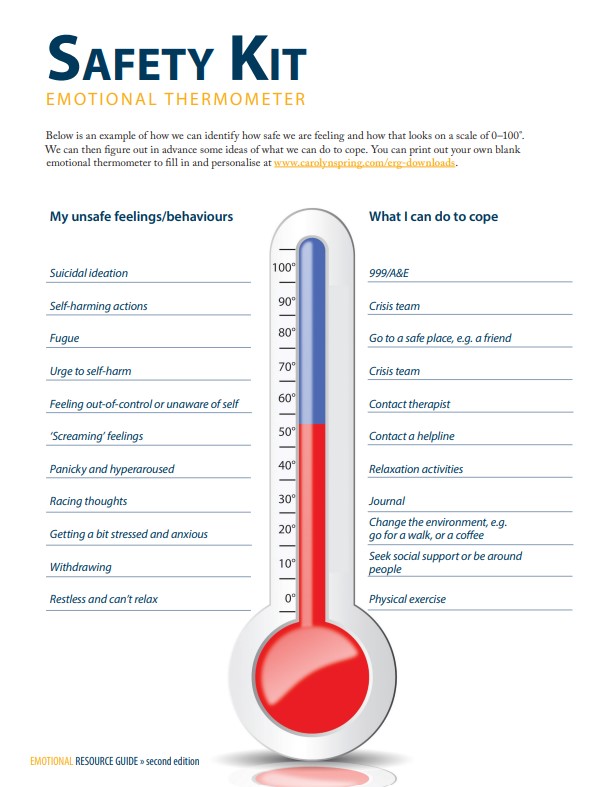Suicidal Feelings and Self Harm
If you’re struggling with suicidal thoughts/feelings or the desire to harm yourself, or have made suicide attempts, we hope you may find the following information and resources helpful.
These resources are the work of Carolyn Spring. Carolyn is now a psychotherapist, but she herself was once stuck in the cycle of self harm and suicide attempts. We feel that her work offers both hope and help to others who are struggling. Her blogs posts and posters (extract below, more links down the right hand side of this page) combine personal insights and practical tips.
At the bottom of this page we have provided a summary of her approach and an introduction to using the resources, as we feel that understanding what is going on inside us can be helpful in learning to cope with it.
‘Suicide — to be or not to be?’ by Carolyn Spring
“Everything screamed at me that pain, this suffering-screech of unbearable despair, would remain until I did something about it, and the only thing I could do about it was to kill myself.
But then I learned that there are things that we can do when we feel big feelings: things that don’t involve suicide, nor even self-harm. Things that are soothing. At first, I wanted just to vomit even at the sound of the words ‘self-soothing’. There was something distinctly, creepily uncomfortable about them, like somehow it was to do with abuse (it’s not) or that it’s selfish (it’s not) or that it shows that I’m not coping (it doesn’t).
I had to learn that self-soothing is merely a set of strategies we can have for helping our emotions to remain within a ‘window of tolerance’ – not too high, not too low. It’s things we can do that help us rebalance, like playing Sudoku; or talking to a friend; or watching comfort telly; or going for a walk; or filing and tidying; or sleeping; or counting backwards; or taking a shower; or cleaning; or shredding old bank statements; or breathing from the belly; or journalling; or birdwatching; or anything at all that helps or distracts or amuses or reassures. Because right at that moment, on that wave of crushing emotion, too often I would freeze and forget that there are things that I can do (other than suicide) that will make things just a teeny bit more bearable, just get me through the next five minutes, just get me acting and being and asserting my right to life, rather than being drowned under the collapsing wave of too-much-too-much.
…
Suicide is not the answer, although I know how much at times it feels as if it must be. I’m glad – now – that I didn’t kill myself. And why didn’t I? Maybe because I am one of the lucky unlucky ones – unlucky enough to have been abused, but lucky enough to have some support now, as an adult, to work it through.
The best response we can have to suicidal people is to support them way before they get to that point, which in times of mental health cuts and austerity measures is easier said than done. But we can still try. I found a purpose in life, of recovery being my best revenge and a deep-in-my-guts need to bring change to this world, as my reason to push through the pain and to keep on living. It’s what gets me out of bed every day of the week: the need to be alive, so that I can change something, and make things better, even if only a little. Judith Lewis Herman talked about a survivor mission being a crucial part of recovery.
We have to find better reasons to live than all our reasons to die. That’s why I don’t like suicide websites, and internet forums which focus only on the negative. I don’t need to be pulled down even lower when I’m already on the floor. I need to look up, and I need other people to help me look up. Empathy is important, but hope is more so. I’m glad I kept on hoping when everything seemed so hopeless. Because recovery is possible, and I could never have imagined back then, when I was twenty, with the paracetamol lined up and the hopelessness of despair beckoning me downwards, that life could be as hopeful and fruitful and positive and blessed as it is for me now. There is hope.”
— from the blog article ‘Suicide — to be or not to be?’ by Carolyn Spring
© Carolyn Spring 2015
Original blog article can be found at:
https://www.carolynspring.com/blog/suicide-to-be-or-not-to-be/
References and further reading
What I would want a therapist to say to me
A short blog post about patient and therapist becoming allies in the goal of reducing distress.
PDF resource © Carolyn Spring 2019
https://www.carolynspring.com
How to calm down
In this blog post, Carolyn shares how she has struggled to manage her emotions and the practical steps she now takes to help calm down.
© Carolyn Spring 2018
Original blog article can be found at: https://www.carolynspring.com/blog/how-to-calm-down/
Self Care and the Golden Goose
Carolyn describes how she went from finding the idea of ‘self care’ annoying and irrelevant, to really learning what it meant and putting it into practice, changing old patterns.
© Carolyn Spring 2011
Original blog article can be found at: https://www.carolynspring.com/blog/self-care/
Self Care: What Would you Do For You?
More on self care! How hard it is, and yet how simple; how it doesn’t need to be bubble baths, and could be watching sport; it’s about rediscovering the things that bring you some joy.
© Carolyn Spring 2017
Original blog article can be found at: https://www.carolynspring.com/blog/self-care-what-would-you-do-for-you/
Emotional Thermometer – with examples
This is one version of a ‘safety kit’ – filled out here with examples.
© Carolyn Spring 2019
Original PDF poster can be found at: https://www.carolynspring.com/wp-content/uploads/2019/12/emotional_thermometer.pdf
Emotional Thermometer – blank for you to use
If you think it could be useful, try filling out your own.
© Carolyn Spring 2019
Original PDF poster can be found at: https://www.carolynspring.com/wp-content/uploads/2019/12/emotional_thermometer_blank.pdf
Emergency Box Poster
One example of an emergency box, some comforting items to have on hand when things are getting tough.
© Carolyn Spring 2019
Original PDF poster can be found at: https://www.carolynspring.com/wp-content/uploads/2021/03/emergency-box.pdf
Trauma Survivors’ Resource Guide
A longer resource, this 100-page e-book for trauma survivors and those who work with and support them, providing explanations and help with flashbacks, triggers, and how to manage our mental health after trauma. It is free to download from Carolyn Spring’s website.
© Carolyn Spring 2021
Original PDF poster can be found at: https://www.carolynspring.com/shop/trauma-survivors-resource-guide
All our helpline workers have received some of Carolyn Spring’s training and can also talk through these resources, ideas and coping strategies with you via the helpline phones or webchat.
Get in touch
You can contact us via our Helpline
Telephone Helpline Opening Hours
Mon 10am-12noon / 1pm-3pm / 8pm-10pm
Tue 10am-12noon / 1pm-3pm / 8pm-10pm
Wed 10am-12noon / 1pm-3pm
Thu & Fri 10am-12noon
0345 458 2914
0117 916 6461
Webchat Opening Hours
Mon 1pm-3pm / 8pm-10pm
Tue 10am-12noon / 8pm-10pm
Thu & Fri 10am-12noon
Understanding What’s Happening
You may find it helpful to know what is going on in your brain and body – in your nervous system – when you’re experiencing distress.
The ‘Trauma Traffic Light’ model illustrates that when all is well, we are in the ‘Green Zone’. Here, the Ventral Vagal Circuit of the Parasympathetic nervous system is online, we feel calm, can think clearly and can engage well with other people.
If something happens to upset us, it can trigger a Fight/Flight response controlled by the Sympathetic Nervous System and push us into the ‘Amber Zone’. Here we feel agitated, can’t think as clearly and can’t engage as well with other people (either conflictual or unable to engage at all).
If the distress is more extreme, we may find ourselves in the ‘Red Zone’ controlled by the Dorsal Vagal Circuit of the nervous system. Here we have more of a Freeze response – dissociation. We have even less ability to think clearly and engage with others.
We have evolved these responses because they can help us to survive dangerous and traumatic situations. However, those of us who have experienced trauma may find ourselves experiencing Amber and Red states over and over, even when we are not currently in situations of danger – and this can be incredibly difficult to live with.
Self harm (including self injury, use of substances, risk-taking behaviour and many other methods) can serve as a coping mechanism when we find ourselves experiencing the agitation and distress of the Amber Zone: our nervous system understands the harm as an even greater level of threat and it releases chemicals in our bodies that act like pain killers or tranquilisers, making us feel calmer. In other words, self harm can bring about the calmer and more dissociative Red Zone/Freeze state which helps us to bear the unbearable.
Building on the Trauma Traffic Light, the pyramid model below shows how all this relates to suicide risk.
This poster shows how ‘suicidal mode’ affects our functioning. You may find you recognise many of your experiences here, for instance how hard it is to think of either the past or the future when you’re feeling suicidal; how you just feel unbearable levels of agitation and distress and don’t know what to do with yourself.
The ‘Vicious Cycle of Self-Harm’ poster illustrates that when we’re distressed, we seek soothing – but if we’re unable to get it (either because we don’t know how, or because someone responds badly to our attempt to get help), we get more distressed. We may then turn to self-harm to cope with the unbearable feelings.
Our bodies actually register this as an increase in threat, and so we move up a level on the Trauma Traffic Light model into a dissociative state (Red Zone). We feel less pain here, but the problem is that somewhere in our brains this event is registered as dangerous, and our overall sense of unsafety and distress increases. This means that we are now more likely to tip over into unbearable distress again in the future – and so we keep moving through the cycle, getting more and more distressed and less able to cope.
The idea is that we want to gradually replace the Vicious Cycle of Self Harm with the Virtuous Cycle of Self Soothing. The poster shows that if we can manage to get soothing when we’re distressed, the event is instead registered as a threat that was manageable, and overall our sense of unsafety decreases. We are now more likely and more able to successfully seek soothing again next time we’re distressed.
So, the aim is to replace self-harming coping mechanisms with some that are less harmful – to re-train ourselves. Carolyn Spring calls this becoming ‘an emotional athlete’.
This may take time and a lot of support (we may need a coach, or several coaches!) but what Carolyn Spring’s own life shows is that it can be done.
Carolyn Spring suggests putting together an ‘Emergency Box’ or toolkit for when you feel really distressed. The idea is to fill it with things that help you do everything you can’t do when you’re so distressed that your thinking is impaired. Examples:
- We know that when in suicidal mode we can’t easily remember past or imagine future, so the box can contain reminders of these
- We also can’t remember how to seek soothing and put healthy strategies into practice, so the box can contain reminders of what works for us!
- We know that in suicidal mode our ‘social engagement’ (ability to relate to others) is impaired, and of course this is very important for soothing – so the box can contain reminders of who to call – and what to say to them to get help!
- The body itself is agitated and needs soothing: the box can contain objects/ fabrics/scents/foods that soothe us.
You might also like to try this version of a safety kit:
Here’s a blank version for you to fill out for yourself.
It’s important that your emergency box/toolkit contains things that soothe and comfort you personally – so you will need to put in some thought and some effort. We are more than happy to support you in thinking it through – you can talk it over with us on the Helpline (phone or webchat).
And of course, a reminder to contact our Helpline (phone or webchat) can be a part of your toolkit (and other services and people too).

